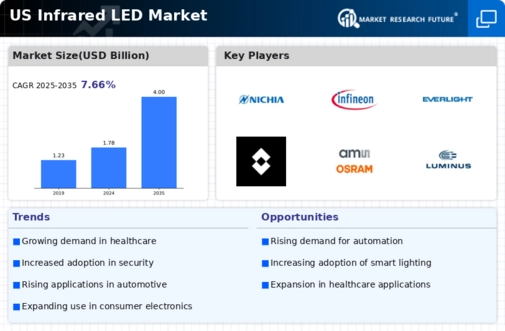Growth in Industrial Automation
The rise of industrial automation is contributing to the expansion of the infrared led market. Industries are increasingly utilizing infrared LEDs in various applications, including machine vision systems, quality control, and process automation. The market for industrial automation is expected to grow significantly, with a projected CAGR of 15% through 2025. This growth indicates a rising demand for infrared LEDs, as they provide essential functionalities in automated systems. Manufacturers must adapt to this trend by developing specialized infrared solutions that cater to the unique requirements of industrial applications.
Expansion of Automotive Applications
The automotive sector is increasingly integrating infrared LED technology for various applications, including night vision systems and advanced driver-assistance systems (ADAS). As safety regulations become more stringent, the demand for enhanced visibility and detection systems is likely to rise. The infrared led market is expected to benefit from this trend, with the automotive segment projected to account for a significant share of the overall market by 2025. This shift indicates a growing recognition of the advantages that infrared LEDs offer in improving vehicle safety and performance, thereby driving further investment in this technology.
Rising Demand for Smart Home Devices
The increasing adoption of smart home technologies is driving the infrared led market. As consumers seek enhanced convenience and security, devices such as smart cameras, motion sensors, and smart lighting systems are becoming prevalent. Infrared LEDs play a crucial role in these applications, providing reliable performance in low-light conditions. The market for smart home devices is projected to grow at a CAGR of approximately 25% through 2025, indicating a robust demand for infrared LEDs. This trend suggests that manufacturers in the infrared led market must innovate to meet the evolving needs of consumers, ensuring compatibility with various smart home ecosystems.
Increased Focus on Security and Surveillance
The heightened emphasis on security and surveillance in both residential and commercial sectors is propelling the infrared led market. With rising concerns over safety, there is a growing demand for infrared cameras and sensors that operate effectively in low-light environments. The market for security cameras is anticipated to reach $10 billion by 2025, with infrared technology being a key component. This trend underscores the importance of infrared LEDs in enhancing the functionality of security systems, suggesting that manufacturers should prioritize the development of high-performance infrared solutions to meet market needs.
Technological Innovations in Lighting Solutions
Innovations in lighting technology are significantly impacting the infrared led market. The development of energy-efficient lighting solutions, such as infrared LED-based lamps, is gaining traction due to their lower energy consumption and longer lifespan compared to traditional lighting. The market for energy-efficient lighting is projected to grow at a CAGR of around 20% through 2025, indicating a shift towards sustainable lighting options. This trend suggests that manufacturers in the infrared led market should focus on research and development to create advanced lighting solutions that align with consumer preferences for energy efficiency.























Leave a Comment